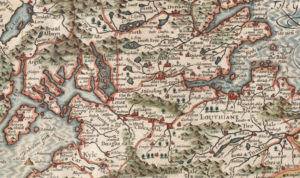The land we now call Sterling was gathered in three distinct grants. The first in 1643, a stretch of land bordering Lancaster purchased from Sholan, the Sachem of the Nashuaggs who resided in the highlands overlooking both Waushacum Ponds. The second purchased by John Moore, John Houghton and Nathaniel Wilder from Tohanto, a nephew of Sholan in 1701. The third in 1768 was created by an act of the Legislature setting off a strip of land from Shrewsbury to Lancaster in the west from the Quinnepoxit River to Stillwater River. A portion of this tract was eventually set off to West Boylston in 1808. Five hills dominate; Rowley Hill, Justice Hill, Fitch’s Hill, Kendall Hill and Redstone Hill. There is also the Wiccapicca or Wekepeke Hill in the north.
Sterling, prior to incorporation in 1781, was known as the “Second Parish of Lancaster” or the “West Precinct of Lancaster” and often called Chocksett, a native American name. It has been claimed that our Town was named for the town of Stirling, Scotland. That may have some coincidental truth as a map of Scotland Establishments dating to the 1600’s shows Stirling had been spelled Sterling. The Establishment of Sterling or Stirling Scotland is quite famous for hosting the National Wallace Monument (of Braveheart fame) and Stirling Castle, the ancestral castle of the Earls of Stirling, the largest castle in Scotland and childhood home to Mary Queen of Scotland 1542-1567.
It is however widely accepted that Sterling was named for William Alexander (1726-1783) known as Lord Stirling, Earl of Stirling, Scotland. Alexander, born in New York, claimed earldom in Scotland, but the Earl of Stirling became dormant with the death of the 5th Lord Stirling, Henry Alexander in 1739. William filed claim which was settled in his favor by a unanimous vote of a jury of twelve in a Scottish court in 1759 however was ultimately turned down by the House of Lords.
Alexander engaged with Governor Shirley in the French and Indian War, served in Battles of Long Island, became Major General and in 1781, when our Town was incorporated, became the Commander of the Northern Army under George Washington. Lord Stirling was considered 3rd or 4th in rank behind General Washington. Lord Stirling ultimately settled in Basking Ridge, New Jersey where he built a palatial estate. He has a proud legacy here in Sterling, Massachusetts but also in Basking Ridge with Lord Stirling Stables, School, Outdoor Education Area, Park and Manor.
A large portrait of Lord Stirling currently rests at the 1835 Town Hall and will be prominently mounted in the Great Hall once Town Hall renovations are complete.

Map of the Kingdome of Scotland 1662; Courtesy of the National Library of Scotland
(Click to enlarge)
